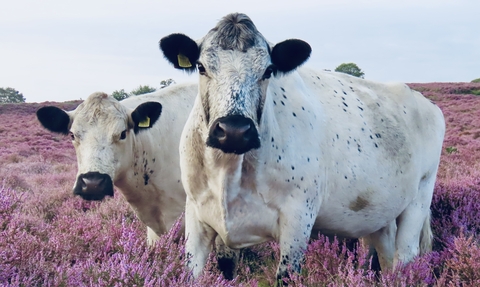
British white cattle (Credit: Julie Smart)
Cattle
Since 2014 Norfolk Wildlife Trust has owned a herd of British White cattle. The breed first appeared in Norfolk in 1765, when Mary Asheton married Sir Harbord of Gunton Hall, bringing with her a breed of cattle from Whalley Abbey in Lancashire that had originated from the wild white cattle found in the area.
Once considered a rare breed; in 1918 only seven herds, containing just 115 females were recorded. Thanks to the efforts of the British White Cattle Society and the Rare Breed Survival Trust these numbers have steadily increased, taking the breed from rare to minority status. The emergence of the breed as an ideal conservation grazer has no doubt helped to popularise this ancient breed.
The way cattle graze is by pulling up tufts of vegetation with their long rough tongue, creating a sward of various heights. At Upton Broad the cattle create ideal conditions for nesting wading birds such as lapwing, a species that has seen breeding numbers decline by 80% since 1960. The cattle produce areas of low grass, favored by the birds to allow a clear view of approaching predators, while tussocks of grass provide many insects for chicks to feed on, as do the miniature ponds created by cows’ feet as they tread into the soft soil.
In the Brecks, following a dramatic reduction in the rabbit population, cattle are being used to restore heathland sites, removing rank vegetation to allow closer cropping of the grass by sheep and the remaining rabbits. This creates the ideal habitat for specialist birds such as the stone curlew and plants like the endemic Breckland thyme.
In West Norfolk, cattle graze Roydon Common, a complex and fragile mosaic of heathland and mire. Here the cattle break up tussocks of dominant purple moor grass, as well as eating invasive species such as birch and willow which, left unchecked, would quickly establish on the site, meaning the loss of heathland species such as nightjar and wood lark.
The breed is hardy, being able to spend the whole year outside, whilst their white coat means they are able to cope with very warm weather too. This coat also allows them to be spotted from a distance, something our volunteer checkers are very grateful for! They are a docile breed, which is important because many of our sites have public access where the cattle have to interact with visitors.
We are slowly increasing our herd of cattle, through selectively breeding from quiet and healthy animals, familiar with our grazing system. This is partly in response to an increase in coarse grass species on our reserves, which is a result of milder wetter winters and increased nitrogen deposits from air-borne pollution. With more cows we can keep these coarse grass species at bay, reducing the risk that they will take the place of rarer, and more delicate grasses and plants.



